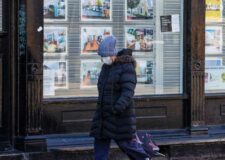Project Brighton: Latest TV’s head of news, Jody Doherty-Cove, shares the harrowing Calais Jungle story

On Saturday 22nd October, a small group of intrepid Brighton filmmakers travelled to the Calais Jungle in order to document the events leading up to eviction day. Among them was Latest TV’s head of news, Jody Doherty-Cove, who had an experience that was inspiring and harrowing. He shares his story exclusively with Latest Homes.
“We woke at 4am, deftly squeezing five bodies and numerous pieces of camera equipment into our tiny car and headed for the Port of Dover. None of us knew what to expect, as we hadn’t exactly planned the trip.
“We arrived at our hotel and split into two teams. My team headed into Calais town to interview some of the locals, the other team went to meet our contact, Elaine, from The Hummingbird Charity, who bring aid to the men, women and children living in the camps around Calais.
“After speaking to people in the town, it became evident that they were all worried for our safety. Two days prior to our arrival a female journalist had been raped at the camp and muggings were a daily occurrence. I met a pub owner, names Jaques, he showed us a map and pointed out the places that were particularly unsafe for journalists.
“The other half of our group who met Elaine were advised not to film or bring camera equipment otherwise it would be stolen. After the first couple of hours we thought we had made a terrible mistake in coming. Although we felt disheartened and incredibly worried, we decided to continue.
“Our first destination was the infamous motorway where we saw migrants trying to get onto the back of trucks. That evening we attended a gathering of charity workers. We discussed what we could film and were invited for a tour of the donations warehouse. 90% of the volunteers there are English, when I asked why the majority was so high, I was told they felt a degree of guilt regarding the way that the UK government has handled the refugee situation.
“The reason why we were advised not to film the migrants is because asylum can only be claimed at the first point of entry, so if migrants are seen in a Calais film or photo by UK authorities, they would be refused entry into Britain.
After speaking to people in Calais town it became evident that they were worried for our safety
“The following morning we entered the Jungle with a great deal of trepidation. It was intimidating at first, but we realised if we smiled, people would smile back. One thing that struck me is just how much admiration the refugees have for the UK. They see it as a mythical place, where everything is amazing. In comparison to how they were living at the camp, this is an understandable assumption.
“The Jungle has its own systems, including shops, a market, cafes and nightclubs. Essentially it’s a shanty town. The refugees we met were very friendly and open, the opinions of the townspeople didn’t tally up with the reality that we found at that point.
“There was a restaurant called the Peace Restaurant, where a lot of journalists and volunteers congregate. We spoke to a BBC crew, who warned us that although the atmosphere was fine at present, it could change in an instant.
“Their prophesy came true at approximately 4.30pm that day. The Jungle is surrounded by a huge fence, funded by the UK government. The fence separates the camp from the motorway to prevent refugees throwing obstructions into the path of trucks. We were standing on a hill and could see the fence and the whole Jungle from this vantage point. We noticed police cars roll up, lots of officers got out with tear gas. We heard shouting and things felt incredibly uneasy. I told the rest of the crew we needed to go.
“Loads of other journalists were also leaving. We made it back to the crossroads where we interviewed more people. When we tried to walk out on one side of the crossroads, a man we spoke to earlier told us not to proceed the way we were going, as he had heard that migrants were mugging reporters at knife point. We went the other way instead. By this time all the press from inside the Jungle were now outside, darkness had fallen and the refugees lit a fire quite close to the wall. The police retaliated with tear gas.
“At this point we were with the police, taking cover behind one of their vans. We had no protective clothing and people started throwing stones at us – it felt like a spectator sport on our part. Here were the refugees being gassed and the press were just pointing cameras at them.
“The police charged in to take control of the fire, launching more tear gas into the camp. At this point the wind changed direction and the tear gas came at us. We started choking and couldn’t run out of it because that would mean running back into the Jungle.
“We ran to take cover up high (tear gas is heavier than air), none of us could see and were just scrambling around. When we reached the top of the hill, I did a piece to camera, then we got out of there.
“Upon reflection I would like to say that in all walks of life there is always 1% of people who are just bad people who do bad things, whether they’re in a refugee camp or not. In a lawless situation like the Jungle, people were suffering and in desperation and acted accordingly. Obviously that situation would bring out the very worst in people. However, 99% of the people we met were just lovely, incredibly friendly people who had a desire to move to the UK for a better life.”
To see the film visit www.thelatest.co.uk (search Calais Jungle story). The Calais Jungle has since been dismantled.




















